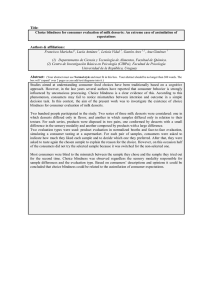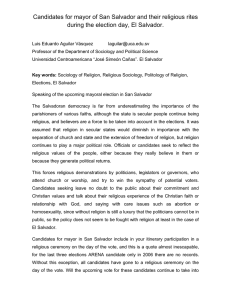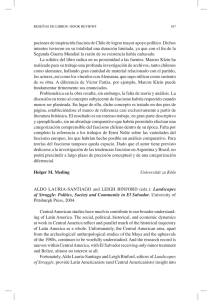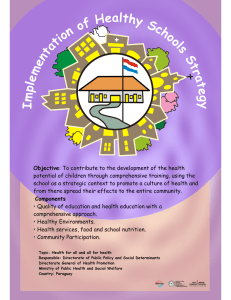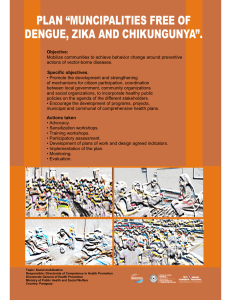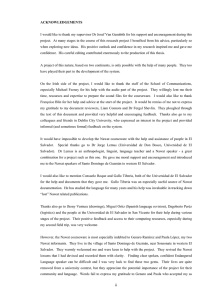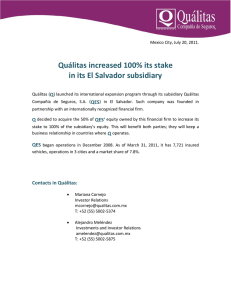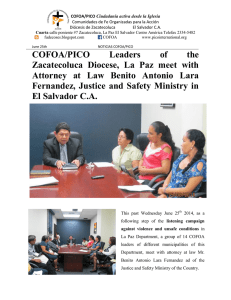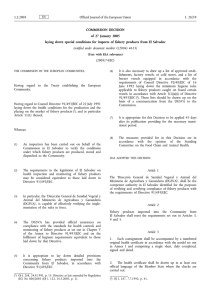Prevalence of visual impairment in El Salvador: inequalities in
Anuncio
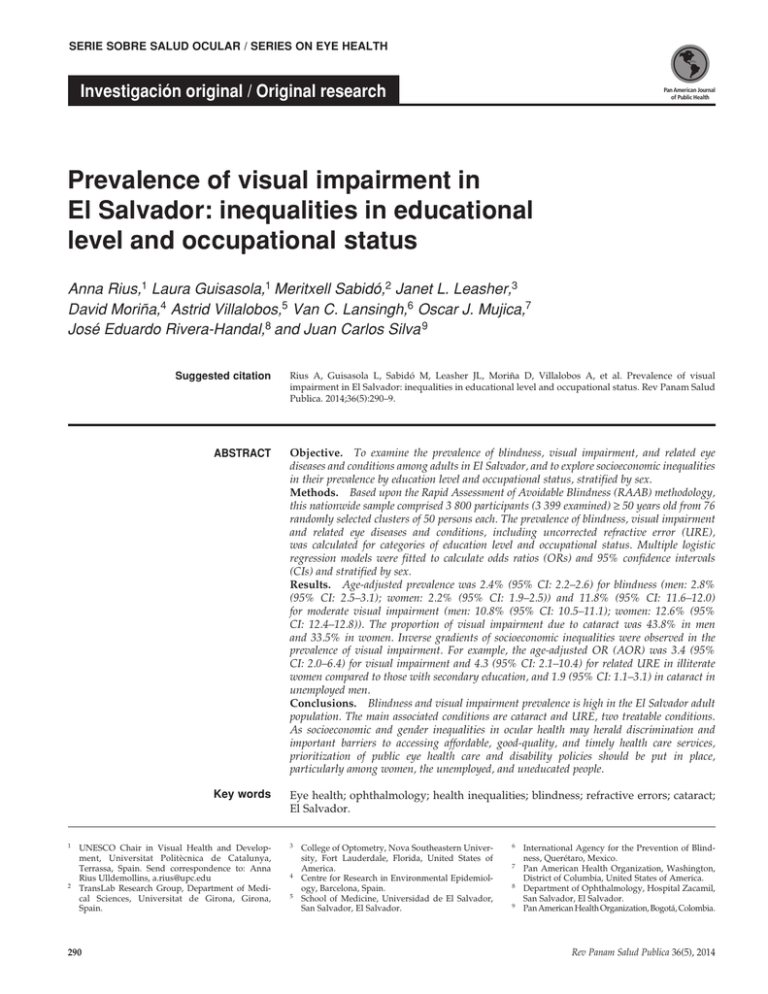
SERIE SOBRE SALUD OCULAR / SERIES ON EYE HEALTH Investigación original / Original research Pan American Journal of Public Health Prevalence of visual impairment in El Salvador: inequalities in educational level and occupational status Anna Rius,1 Laura Guisasola,1 Meritxell Sabidó,2 Janet L. Leasher,3 David Moriña,4 Astrid Villalobos,5 Van C. Lansingh,6 Oscar J. Mujica,7 José Eduardo Rivera-Handal,8 and Juan Carlos Silva 9 1 Suggested citation Rius A, Guisasola L, Sabidó M, Leasher JL, Moriña D, Villalobos A, et al. Prevalence of visual ­impairment in El Salvador: inequalities in educational level and occupational status. Rev Panam Salud Publica. 2014;36(5):290–9. abstract Objective. To examine the prevalence of blindness, visual impairment, and related eye diseases and conditions among adults in El Salvador, and to explore socioeconomic inequalities in their prevalence by education level and occupational status, stratified by sex. Methods. Based upon the Rapid Assessment of Avoidable Blindness (RAAB) methodology, this nationwide sample comprised 3 800 participants (3 399 examined) ≥ 50 years old from 76 randomly selected clusters of 50 persons each. The prevalence of blindness, visual impairment and related eye diseases and conditions, including uncorrected refractive error (URE), was calculated for categories of education level and occupational status. Multiple logistic regression models were fitted to calculate odds ratios (ORs) and 95% confidence intervals (CIs) and stratified by sex. Results. Age-adjusted prevalence was 2.4% (95% CI: 2.2–2.6) for blindness (men: 2.8% (95% CI: 2.5–3.1); women: 2.2% (95% CI: 1.9–2.5)) and 11.8% (95% CI: 11.6–12.0) for moderate visual impairment (men: 10.8% (95% CI: 10.5–11.1); women: 12.6% (95% CI: 12.4–12.8)). The proportion of visual impairment due to cataract was 43.8% in men and 33.5% in women. Inverse gradients of socioeconomic inequalities were observed in the prevalence of visual impairment. For example, the age-adjusted OR (AOR) was 3.4 (95% CI: 2.0–6.4) for visual impairment and 4.3 (95% CI: 2.1–10.4) for related URE in illiterate women compared to those with secondary education, and 1.9 (95% CI: 1.1–3.1) in cataract in unemployed men. Conclusions. Blindness and visual impairment prevalence is high in the El Salvador adult population. The main associated conditions are cataract and URE, two treatable conditions. As socioeconomic and gender inequalities in ocular health may herald discrimination and important barriers to accessing affordable, good-quality, and timely health care services, prioritization of public eye health care and disability policies should be put in place, particularly among women, the unemployed, and uneducated people. Key words Eye health; ophthalmology; health inequalities; blindness; refractive errors; cataract; El Salvador. UNESCO Chair in Visual Health and Development, Universitat Politècnica de Catalunya, Terrassa, Spain. Send correspondence to: Anna ­ Rius Ulldemollins, [email protected] 2 TransLab Research Group, Department of Medical Sciences, Universitat de Girona, Girona,­ Spain. 290 3 College of Optometry, Nova Southeastern University, Fort Lauderdale, Florida, United States of America. 4 Centre for Research in Environmental Epidemiology, Barcelona, Spain. 5 School of Medicine, Universidad de El Salvador, San Salvador, El Salvador. 6 International Agency for the Prevention of Blindness, Querétaro, Mexico. 7 Pan American Health Organization, Washington, District of Columbia, United States of America. 8 Department of Ophthalmology, Hospital Zacamil, San Salvador, El Salvador. 9 Pan American Health Organization, Bogotá, ­Colombia. Rev Panam Salud Publica 36(5), 2014 Rius et al. • Inequalities in the prevalence of visual impairment in El Salvador It is estimated that worldwide 32.4 million people are blind and 191 million people have moderate and severe visual impairment (1). Several population-based studies report women have a higher age-adjusted prevalence of blindness, visual impairment, and related eye diseases and conditions (1, 2). Up to 80% of blindness and 85% of ­visual impairment worldwide is avoidable (3). Treatment of the two main proximal causes, cataract and uncorrected refractive error (URE), is considered to be one of the most cost-effective interventions (4, 5). Socioeconomic status is recognized as a distal determinant of the prevalence of blindness and visual impairment (6). Illiteracy and lower levels of education have been associated with higher prevalence of blindness and visual impairment (7–15) and the main eye-related diseases and conditions, such as cataract (10) and URE (16), particularly among women (17). In Europe, visual impairment has been associated with not having a paid job, having a permanent disability (18), and manual social class (17), and in India, it is associated with unemployment (19). This trend was not found in the United States, however, based on one study that found similar levels of low vision and blindness prevalence in both workers and the unemployed (20). In the Latin America and Caribbean region, in 2010, it was estimated that in all age groups there were 2.3 million blind people (presenting visual acuity (PVA) < 3/60) and 14.1 million people with severe visual impairment (SVI) (PVA < 6/60–3/60) or moderate visual impairment (MVI) (PVA < 6/18–6/60) (21). This same study reported that among those 50 years old and older, the Central America subregional agestandardized prevalence of blindness is estimated to be 1.8% (95% confidence interval (CI): 1.4–2.4) in men and 2.0% (95% CI: 2.0–3.1) in women, and SVI and MVI is estimated to be 9.8% (95% CI: 7.6–12.6) among men and 11.4% (95% CI: 8.7–14.7) among women. However, to the best of the authors’ knowledge, no national prevalence data has been published previously for Central American countries. In 2009, the governments of Central America signed a Pan American Health Organization (PAHO) Directing Council Resolution to develop an Action Plan for the Prevention of Blindness that Rev Panam Salud Publica 36(5), 2014 required assessing the prevalence and distribution of visual impairment and eye diseases in the population (22). In line with the scenario described above, this study aimed to estimate the national prevalence of blindness, visual impairment, and related eye diseases and conditions, including URE, among adults in El Salvador. In addition, by adding measures of individual socioeconomic status to the standardized Rapid Assessment of Avoidable Blindness (RAAB) protocol (23), the updated and modified version of the Rapid Assessment of Cataract Surgical Services (RACSS) methodology developed by the World Health Organization (WHO) (24), this study aimed to determine any differences related to education level and occupational status independent of age, and whether these patterns differ as a function of sex. The authors’ hypothesis is that blindness, visual impairment, and related eye diseases and conditions are more frequent among individuals who are unemployed or have a lower level of education, especially women, even after adjusting for age. MATERIALS AND METHODS This study used the standard RAAB methodology (23) for collecting baseline data on blindness and visual impairment in adults ≥ 50 years old in El Salvador. Two new questions were included in the RAAB methodology to evaluate educational and occupational status. All clinicians and interviewers were trained by certified personnel according to RAAB methodology protocols and a pilot study was conducted to ensure compliance with the methodology. Data acquisition The 2007 census indicated that there were an estimated 941 000 people ≥ 50 years old in 10 771 districts in El Salvador (25). The reference population stratified by educational level and occupation status was obtained from El Salvador’s Bureau of Statistics and Census (Dirección General de Estadística y Censos, ­ DIGESTYC) (25, 26). The required sample size for an estimated prevalence of blindness of 4.0% (27) was calculated using the RAAB software package, assuming a variation of 20% around the estimate, with a probability of 95%, a Original research design effect of 1.5, and a noncompliance of 10%. Using standardized RAAB multi-stage cluster sampling, 76 randomly selected clusters of 50 persons were identified, resulting in a total of 3 800 eligible participants representing the entire country. In each cluster, 50 people 1) were interviewed in their homes by five teams that included certified ophthalmologists and medical residents and 2) received an eye examination that included a visual acuity (VA) measurement using a Snellen “E” chart. If visual impairment or blindness was detected, ophthalmologists diagnosed the primary cause using portable instruments and recorded the data using the standard RAAB survey record, a modified version of the form used in the RACSS methodology. Self-reported socio-demographic data on age, sex, educational level, and occupation status were also collected. Measures Visual acuity measurement. Presenting monocular VA was measured and the results for the better eye were categorized as blindness (PVA < 3/60) or visual impairment (VA < 6/18 and ≥ 3/60), and subcategorized as MVI (PVA < 6/18– 6/60) or SVI (VA < 6/60–3/60), according to the International Classification of Diseases, 10th Revision (ICD-10) (28). Eye diseases and conditions. Among visually impaired and blind individuals, related eye diseases and conditions were classified as URE; cataract; posterior segment (including primary glaucoma, diabetic retinopathy, age-related macular degeneration (AMD), and other disorders of the posterior segment); complications; corneal opacities; aphakia; and trachoma. The lens status of all participants was assessed with a flashlight to calculate cataract surgical coverage (CSC). An additional measure of VA with a pinhole was performed to the visually impaired or blind individuals who have undergone cataract surgery (23). Age groups. Age was categorized into four groups: 50–59 years; 60–69 years; 70–79 years; and ≥ 80 years. Educational level. Educational level was obtained using the question “What is the highest level of education you have completed?” Possible answers followed 291 Original research the classification used in El Salvador’s national census (24) and were classified as one of three levels: 1) illiterate (can not read or write); 2) primary education or less (primary education or equivalent, or incomplete primary education grade 1–6); or 3) secondary education or more (first- or second-stage secondary school (years 7, 8, or 9), technical careers, or university degree or equivalent). Occupational status. To assess occupational status, all eligible individuals were asked, “In relation to economic activity, what was your situation last week?” In accordance with El Salvador’s Multipurpose Household Survey (25), answers were categorized into six groups: working; unemployed; receiving pension; disabled or unable to work; homemaker; or other situation (unpaid job, volunteer work, student, or other). The last five categories were also classified as nonworking status. Statistical analysis Prevalence estimation. Distribution and prevalence and 95% binomial CIs for blindness, visual impairment, and related eye diseases and conditions (including URE) of those who also had visual impairment or blindness were calculated by age group, education level, and occupational status. The distribution in the reference population and the study sample of blindness, visual impairment, and related eye diseases and conditions were compared using the chi-square test. Multiple logistic regression models were used to calculate socioeconomic inequalities through crude odds ratios (ORs) and age-­adjusted ORs (AORs) and their 95% CIs. All analyses were stratified by sex. Data were processed using the R software (version 3.0.0) (Wirtschaftsuniversität Wien, Vienna, Austria) (29). Health inequities. Secondary education and “employed” status were normatively defined as equity standard categories. Relative measures of social (i.e., education and occupational) inequalities in eye diseases were assessed by ORs and AORs. Absolute inequalities (expressed in percentage points) were computed as the arithmetic difference between point prevalence in the social categories other than the equity standard and the equity standard. 292 Rius et al. • Inequalities in the prevalence of visual impairment in El Salvador RESULTS Study sample A total of 3 399 subjects were examined (response rate 89.4%). Of those who were not examined, 262 (6.9%) were not available after two attempts, 123 (3.3%) refused to participate, and 16 (0.4%) had communication problems. More men than women were absent (8.0% men versus 6.1% women; P = 0.02) or refused to participate (4.2% men versus 2.6% women; P = 0.005). The nonresponse rates for questions on occupational status (3.5%) and education level (3.2%) were similar to those for other variables and nonsignificant differences were observed between sexes. Sample characteristics and descriptive statistics for those who were blind and visually impaired, stratified by sex, are shown in Table 1; significant differences were observed between the reference population and the study sample in the distribution of age, education level, and occupational status, stratified by sex. A total of 34% of blind and 50% of visually impaired men were working. Among women, no one with blindness was employed, but 10% of those visually impaired were working. Prevalence of blindness, visual impairment, and related eye diseases and conditions The age-adjusted prevalence of blindness was 2.4% (95% CI: 2.2–2.6) (men, 2.8% (95% CI: 2.5–3.1); women, 2.2% (95% CI: 1.9–2.5)); severe visual impairment, 2.5% (95% CI: 2.3–2.7) (men, 2.7% (95% CI: 2.4–3.0); women, 2.4% (95% CI: 2.1–2.7)); and moderate visual impairment, 11.8% (95% CI: 11.6–12.0) (men, 10.8% (95% CI: 10.5–11.1); women, 12.6% (95% CI: 12.4–12.8)) (Table 2). Cataract was the most common cause among blind individuals (men, 66.7%; women, 70.6%) and URE was the most common cause among visually impaired individuals (men, 49.1%; women, 57.6%). The distribution of each related eye disease or condition differed between blind and visually impaired individuals (P < 0.001) (Table 1). Prevalence of blinding cataract was 2.0% (95% CI: 1.5–2.5) (men, 2.3% (95% CI: 1.5–3.1); women, 1.8% (95% CI: 1.2–2.4)) and prevalence of blinding posterior segment pathologies was 0.5% (95% CI: 0.3–0.7) (0.2% (95% CI: 0.0–0.5) in men and 0.1% (95% CI: 0.0–0.2) in women for primary glaucoma; 0.1% (95% CI: 0.0–0.2) in men and 0.2% (95% CI: 0.0–0.4) in women for diabetic retinopathy; and 0.2% (95% CI: 0.0–0.5) in men and 0.0% (95% CI: 0.0–0.1) in women for AMD). Prevalence of visual impairment resulting from URE was 8.8% (95% CI: 7.8–9.8) (8.0% (95% CI: 6.6–9.5) in men and 9.4% (95% CI: 8.1–10.6) in women) (Table 2). Global coverage of cataract surgery was 34.2% (36.6% in men and 32.2% in women) and was lower in illiterates (31.3% in men and 28.4% women) than in individuals with secondary education or higher (37.9% in men and 41.7% in women) (not shown). Of all eyes that had cataract surgery, 55.6% could see 20/60 or better and 22.7% could not see 20/200 with the available correction. Using a pinhole, the results improved in 65.7% of cases (not shown). Education and occupational inequalities The overall prevalence of visual impairment and related cataract or URE differed significantly according to edu­cation level and occupational status (Table 3). Illiterate individuals had higher odds (and therefore a higher prevalence) of visual impairment (OR = 3.9 (P < 0.001)), cataract (OR = 3.1 (P < 0.001)), and URE (OR = 4.0 (P < 0.001)) compared to those with secondary education or higher. Compared to those working, there was a higher prevalence of visual impairment, cataract, and URE among both disabled nonworking individuals (OR = 4.5 (P < 0.001), 5.5 (P < 0.001), and 2.8 (P < 0.001) respectively) and the un­ employed (OR = 3.1 (P < 0.001), 5.1 (P < 0.001), and 1.4 (P = 0.91) respectively). The increased prevalence among the unemployed versus the employed was statistically significant for cataract and visual impairment but not for URE. Socioeconomic inequalities partly explained by age After adjusting for age, illiterate individuals still had significantly higher odds (and therefore a higher prevalence) of visual impairment (AOR = 2.3 (P < 0.001)), and of URE (AOR = 3.0 (P < 0.001)) than those with at least secondary education Rev Panam Salud Publica 36(5), 2014 Rev Panam Salud Publica 36(5), 2014 30.6 50.5 14.7 17.2 30.9 20.6 1.1 30.3 127 513 210 459 61 345 25 104 45 119 30 044 1 543 44 174 — — — — — — — 190 114 53 50 923 445 637 286 501 410 280 187 1 378 No. % 14.3 8.6 4.0 3.8 69.4 32.3 46.2 20.8 36.4 29.8 20.3 13.6 40.5 Study Sample < 0.001 < 0.001 < 0.001 < 0.001 p Men 111 99 13 3 0 0 0 54 28 19 8 108 107 91 26 22 53 76 75 228 No. VI 49.1 43.8 5.8 1.3 0.0 0.0 0.0 24.9 12.9 8.8 3.7 49.8 47.8 40.6 11.6 9.7 23.5 33.6 33.2 16.4 % 1 32 9 1 5 0 0 14 1 9 5 15 26 17 5 9 9 7 23 48 2.1 66.7 18.8 2.1 10.4 0.0 0.0 31.8 2.3 20.5 11.4 34.1 54.2 35.4 10.4 18.8 18.8 14.6 47.9 3.5 % Blindness No. the visually impaired and blind population. applicable. glaucoma, diabetic retinopathy, age-related macular degeneration, and other disorders of the posterior segment. c Primary b Not a Among 42.4 29.7 18.5 9.3 176 993 123 988 77 107 38 901 —b — — — — — — 44.3 416 989 Total Age group (years) 50–59 60–69 70–79 ≥ 80 Education level Illiterate Primary or less Secondary or more Occupational status Unemployed Receiving pension Disabled or unable to work Homemaker Working Related eye disease/condition a Uncorrected refractive error Cataract Posterior segmentc Complication Corneal opacities Aphakia Trachoma corneal opacity % No. Characteristic Reference population — — — — — — — 2 749 37 557 25 927 1 550 17 501 221 533 233 223 56 113 22 1816 153 033 96 334 52 828 524 011 No. 3.2 44.0 30.4 1.8 20.5 42.3 44.5 10.7 42.3 29.2 18.4 10.1 55.7 % Reference population — — — — — — — 51 47 19 1 540 322 870 864 262 824 564 419 214 2 021 No. % 2.6 2.4 1.0 77.8 16.3 43.0 42.8 13.0 40.8 27.9 20.7 10.6 59.5 Study Sample < 0.001 0.005 0.03 < 0.001 p Women 189 110 18 7 1 2 1 14 6 7 268 32 201 112 14 60 91 85 92 328 No. VI 57.6 33.5 5.5 2.1 0.3 0.6 0.3 4.3 1.8 2.1 82.0 9.8 61.5 34.3 4.3 18.3 27.7 25.9 28.0 16.2 % 3 36 8 1 2 0 1 2 0 4 45 0 40 9 2 4 6 18 23 51 No. 5.9 70.6 15.7 2.0 3.9 0.0 2.0 3.9 0.0 7.8 88.2 0.0 78.4 17.6 3.9 7.8 11.8 35.3 45.1 2.5 % Blindness Table 1. Characteristics of reference population, study sample, and study sample participants diagnosed with visual impairment (VI), blindness, and related eye diseases and conditions using the Rapid Assessment of Avoidable Blindness (RAAB) methodology, by sex, age, education level, and occupational status, El Salvador, 2011 Rius et al. • Inequalities in the prevalence of visual impairment in El Salvador Original research 293 Original research Rius et al. • Inequalities in the prevalence of visual impairment in El Salvador TABLE 2. Age-adjusted prevalence of blindness and visual impairment and crude prevalence of related eye diseases and conditions in adults ≥ 50 years old, based on the Rapid Assessment of Avoidable Blindness (RAAB) methodology, El Salvador, 2011 Visual impairment (PVAa < 6/18 to ≥ 3/60) Blindness, visual impairment, related eye disease or condition Blindness (age-adjusted prevalence) Visual impairment (age-adjusted prevalence) Moderate (PVA < 6/18–6/60) Severe (PVA < 6/60–3/60) Eye disease/conditiond causing visual impairment or blindness (crude prevalence) Uncorrected refractive error Cataract Posterior segmente Complication Corneal opacities Aphakia Trachoma corneal opacity Blindness (PVA < 3/60) Men % (CIb) Women % (CI) Total % (CI) Men % (CI) Women % (CI) Total % (CI) —c 18.8 (18.5–19.1) 10.8 (10.5–11.1) 2.7 (2.4–3.0) — 19.2 (19.0–19.4) 12.6 (12.4–12.8) 2.4 (2.1–2.7) — 19.9 (19.6–20.2) 11.8 (11.6–12.0) 2.5 (2.3–2.7) 2.8 (2.5–3.1) — — — 2.2 (1.9–2.5) — — — 2.4 (2.2–2.6) — — — 8.0 (6.6–9.5) 7.2 (5.8–8.5) 0.9 (0.4–1.5) 0.2 (0.0–0.5) ...f ... … 9.4 (8.1–10.6) 5.4 (4.5–6.4) 0.9 (0.3–1.4) 0.4 (0.1–0.6) 0.1 (0.0–0.1) 0.1 (0.0–0.2) 0.1 (0.0–0.1) 8.8 (7.8–9.8) 6.1 (5.3–6.9) 0.9 (0.6–1.2) 0.3 (0.1–0.5) 0.03 (0.0–0.09) 0.06 (0.0–0.1) 0.03 (0.0–0.09) 0.1 (0.0–0.2) 2.3 (1.5–3.1) 0.7 (0.0–0.7) 0.1 (0.0–0.3) … … 0.4 (0.1–0.7) 0.2 (0.0–0.3) 1.8 (1.2–2.4) 0.4 (0.0–0.6) 0.1 (0.5–0.2) 0.1 (0.0–0.2) … 0.1 (0.0–0.2) 0.1 (0.0–0.2) 2.0 (1.5–2.5) 0.5 (0.3–0.7) 0.06 (0.0–0.1) 0.03 (0.0–0.09) … 0.2 (0.05–0.4) a Presenting visual acuity. confidence interval. c Not applicable. d Prevalence of eye disease or condition as well as visual impairment or blindness (or causing visual impairment or blindness) among general population. e Primary glaucoma, diabetic retinopathy, age-related macular degeneration, and other disorders of the posterior segment. f No observations. b 95% (Table 3). Indeed, an education inverse gradient was observed. Compared to those working, the higher odds of visual impairment among the disabled (AOR = 1.8 (P < 0.001)) and the unemployed (AOR = 1.4 (P < 0.001)) remained significant after adjusting by age. Compared to those working, significantly higher odds of cataract persisted after adjusting for age among those who were unemployed (AOR = 1.8 (P < 0.001)). Inequality patterns differed by sex No significant differences in the overall prevalence of blindness, visual impairment, or related eye diseases and conditions were observed between men and women (Table 2), even though women showed higher socioeconomic disparities. Different patterns between sexes were observed after stratifying the data by education level and occupational status (Table 4). While a higher prevalence of visual impairment, related cataract, and URE was observed among both men and women with a lower level of education, the differences between illiterate individuals and those with a high level of education were greater among women (­visual impairment: ORmen = 3.2 (p < 0.001), ORwomen = 5.3 (p < 0.001); cataract: ORmen = 2.7 (p < 0.001), ORwomen = 4.8 (p < 0.001); URE: ORmen = 3.0 (p < 0.002), ORwomen = 5.3 (P < 0.001)). Differences 294 between men and women were also observed after stratifying the data according to occupational status. The prevalence of visual impairment and cataract was lower among women with a job or receiving a pension compared to men. Inequalities after adjusting for age in the prevalence of visual impairment and URE in low-education–level individuals compared to those who were highly educated only remained significant among women (visual impairment: ORmen = 1.5 (P < 0.08), ORwomen = 3.4 (P < 0.001); URE: ORmen = 1.8 (P < 0.09), ORwomen = 4.3 (P < 0.001)) (Table 4). DISCUSSION This study produced four main findings: 1) cataract and URE were the two most prevalent eye conditions in blind and visually impaired populations respectively; 2) lower education level and unemployment were associated with higher prevalence of visual impairment, related cataract, and URE; 3) socioeconomic inequalities in the overall prevalence of visual impairment remained after adjusting for age; and 4) the socioeconomic inequalities observed were higher among women. This study was based on a randomized sample from El Salvador and to the best of the authors’ knowledge is the first nationally representative population-based study of visual impairment and blind- ness in Central America. Moreover, the inclusion of variables for education level and occupational status allowed the research team to improve the precision of previous research by stratifying the analysis by socioeconomic status and sex, thus incorporating an equity analysis into the RAAB methodology. The study results placed El Salvador fifth highest in the ranking of prevalence of blindness and fourth highest in visual impairment among those ≥ 50 years old compared to other countries in Latin America (21). These results confirm the authors’ hypotheses that visual impairment is more common in less educated and unemployed individuals, particularly among poorly educated women and unemployed men. This study shows that both cataract and URE are highly prevalent among the blind and visually impaired, as expected (30). Both conditions can be effectively treated (through an outpatient surgical procedure, for cataract, and optical correction for URE). Only 15% of the patients diagnosed with cataract who were examined in this study had already been treated, and only 45% of patients who needed compensation for an URE causing a visual impairment were wearing it at the time of the examination (results not shown). The low coverage of cataract surgical services and spectacle correction suggests there is a need to strengthen eye care services. Adequately treating Rev Panam Salud Publica 36(5), 2014 0.81–3.20 0.93–1.63 1.7 1.2 1 2.8 1.37–5.17e 1.6 1.19–2.07e 1 12 16.7 (8.1, 25.3) 162 10.2 (8.7, 11.7) 84 6.7 (5.4, 8.1) 0.80–3.05 0.74–1.46 1.6 1.0 1 2.88–9.86e 1.22–2.28e 5.5 1.7 1 16 22.2 (12.6, 31.8) 127 8.0 (6.7, 9.3) 62 5.0 (3.8, 6.2) 1.8 1.2 1 2.64–7.39e 1.33–2.07e c a Odds ratios. b Age-adjusted ORs. Confidence intervals. d Presenting visual acuity. e P < 0.05. 4.5 1.7 1.0 36.1 (25 –47.2) 17.4 (15.5–19.2) 11.2 (9.5–13) 26 276 140 Rev Panam Salud Publica 36(5), 2014 Original research 1.04–3.15e 0.93–1.48 0.53–1.47 0.99–3.07 0.9 1.8 1.4 0.81–2.23 1.9 1.06–3.07e 22 9.1 (5.5, 12.8) 19 11.8 (6.8, 16.8) 1.16–2.83e 0.44–1.64 1.8 0.9 3.42–7.64e 0.96–3.23 5.1 1.8 51 21.2 (16, 26.3) 14 8.7 (4.3, 13) 1.4 1.5 28.2 (22.5–33.9) 21.1 (14.8–27.4) 68 34 3.9 2.0 1.0 23.4 (21.1–25.7) 13.5 (11.8–15.3) 7.3 (5.1–9.5) 308 203 40 3.1 2.1 2.22–4.31e 1.38–3.18e 1.00–2.06e 0.95–2.38 3.0 1.84–5.13e 2.4 1.49–4.14e 1 158 12.0 (10.3, 13.8) 4.0 2.51–6.84e 128 8.5 (7.1, 9.9) 2.8 1.70–4.69e 18 3.3 (1.8, 4.8) 1 0.85–2.15 0.50–1.31 1.3 0.8 1 2.04–4.86e 0.75–1.90 3.1 1.2 1 169 12.8 (11, 14.7) 80 5.3 (4.2, 6.5) 25 4.6 (2.8, 6.3) 1.60–3.29e 1.12–2.31e 2.3 1.6 1 2.78–5.57e 1.41–2.87e 1 2.1 1.51–2.95e 2.6 1.84–3.68e 2.8 1.90–4.17e CI AOR CI OR 1 2.3 1.65–3.21e 3.0 2.16–4.26e 3.4 2.34–5.02e 61 4.6 (3.5, 5.7) 97 10.0 (8.1, 11.8) 89 12.7 (10.3, 15.2) 57 14.2 (10.8, 17.6) 1 25 1.9 (1.2, 2.6) 1 1 2.4 1.82–3.24e 45 4.6 (3.3, 5.9) 2.5 1.55–4.19e 2.4 1.46–3.98e 3.9 2.95–5.28e 76 10.9 (8.6, 13.2) 6.3 4.06–10.26e 5.8 3.66–9.43e 8.7 6.42–11.92e 131 32.7 (28.1, 37.3) 22.2 16.41–40.30e 21.3 13.65–34.57e 1.98–3.51e 3.42–6.05e 8.05–14.64e 6.2 (4.9–7.5) 1 14.8 (12.6–17) 2.6 23 (19.9–26.2) 4.5 41.6 (36.8–46.5) 10.8 82 144 161 167 Age group (years) 50–59 60–69 70–79 ≥ 80 Education level Illiterate Primary or less Secondary or more Occupational status Unemployed Receiving pension Disabled or unable to work Homemaker Working Uncorrected refractive error % (CI) No. CI AOR CI Cataract OR % (CI) No. % (CI) OR CI AOR CI Characteristic No. Visual impairment (moderate and severe) (n = 556) TABLE 3. Crude prevalence, ORs,a AORs,b and 95% CIsc of visual impairment (PVAd < 6/18 and ≥ 3/60), related cataract, and uncorrected refractive error by age group, education level, and occupational status in adults ≥ 50 years old, based on the Rapid Assessment of Avoidable Blindness (RAAB) methodology, El Salvador, 2011 Rius et al. • Inequalities in the prevalence of visual impairment in El Salvador patients who suffer from cataract or URE could reduce 72.7% of the blindness and 94.0% of the visual impairment encountered in El Salvador, assuming that the cataract was not obscuring posterior segment disease. Socioeconomic inequalities were observed among individuals visually impaired by cataract, with a higher prevalence among those with a low education level and the nonworking population. This inequality could be due to the quality of public services, differences in coverage in public hospitals among individuals with low socioeconomic status, or an unequal ability to pay substitutive services. Approximately 1 in 3 women and 1 in 5 men who were blind due to cataract indicated that they had not been treated because of economic constraints (results not shown). The results also indicated cataract surgery coverage was higher among highly educated individuals (men, 37.9%; women, 41.7%) than among the illiterate (men, 31.3%; women, 28.4%) (not shown) and, as expected based on previous studies (31), there were no crude differences by gender. El Salvador is characterized by significant inequalities; the average annual salary of illiterate individuals (35% of the population ≥ 50 years) is US$ 145.31 compared to US$ 601.35 for highly educated individuals (26). Cataract surgery is provided free of charge by public hospitals in El Salvador, but in the current results (not shown) only 48% individuals operated for cataract had had the surgery conducted in a public hospital. Given that the average cost of the procedure in the private sector in 2008 was between US$ 750 in a private eye care center and US$ 175 (32) in a nonprofit eye care center, and that the average monthly income in El Salvador is US$ 498.09 per household (26), this procedure is not affordable for a significant portion of the Salvadoran population. In addition, prevention and treatment of blindness has not been a priority for the government, as per the current five-year national health strategic plan (2009–2014) (33). The country is underserved by ophthalmology services, with a catchment area of only 6 out of 30 public hospitals covered by those services (32). Those persons who are excluded from access are those with the least income and lowest education levels. Lower therapeutic effort by health personnel could also be related to longer waiting lists and variance in therapeutic 295 296 Characteristic ratios. c ORs. Confidence intervals. d Presenting visual acuity. e P < 0.05. f Not applicable. b Age-adjusted a Odds Visual impairment (moderate and severe) Age group (years) 50–59 60–69 70–79 ≥ 80 Education level Illiterate Primary or less Secondary or more Occupational status Unemployed Receiving pension Disabled or unable to work Homemaker Working Cataract Age group (years) 50–59 60–69 70–79 ≥ 80 Education level Illiterate Primary or less Secondary or more Occupational status Unemployed Receiving pension Disabled or unable to work Homemaker Working URE Age group (years) 50–59 60–69 70–79 ≥ 80 Education level Illiterate Primary or less Secondary or more Occupational status Unemployed Receiving pension Disabled or unable to work Homemaker Working 4.4 (2.6–6.2) 12.9 (9.7–16.2) 27.1 (21.9–32.3) 40.1 (33.2–47.3) 24.0 (20.1–28.0) 14.3 (11.6–17.0) 9.1 (5.6–12.4) 28.4 (22.0–34.8) 24.6 (16.7–32.5) 35.9 (22.9–48.8) 16.0 (5.8–26.2) 11.7 (9.6–13.8) 2.9 (1.5, 4.5) 5.1 (3, 7.3) 12.1 (8.3, 16) 32.6 (25.9, 39.3) 15.3 (11.9, 18.6) 6.7 (4.8, 8.7) 6.3 (3.5, 9.1) 22.1 (16.2, 28) 9.6 (4.2, 15.1) 24.5 (12.9, 36.1) 8.0 (0.5, 15.5) 6.0 (4.4, 7.5) 3.0 (1.5, 4.5) 7.6 (5, 10.1) 14.6 (10.5, 18.8) 13.4 (8.5, 18.2) 10.6 (7.7, 13.4) 8.5 (6.3, 10.6) 3.8 (1.6, 6.1) 8.9 (4.9, 13) 14.0 (7.7, 20.4) 18.9 (8.3, 29.4) 6.0 (0.0, 12.6) 6.6 (5, 8.2) 107 91 26 54 28 19 8 108 15 21 34 61 68 43 18 42 11 13 4 55 15 31 41 25 47 54 11 17 16 10 3 61 % (CI) 22 53 76 75 No. 1.4 2.3 3.3 0.9 1 3.0 2.3 1 1 2.7 5.5 5.0 4.5 1.7 5.1 1.4 1 2.7 1.1 1 1 1.8 4.5 15.7 3.0 2.5 4.2 1.4 1 3.2 1.7 1 1 3.2 8.1 14.6 OR 1.4 1.3 1.9 0.9 1 2.05–4.34e 1.51–3.90e 2.29–7.58e 0.61–2.99 0.77–2.38 1.24–4.07e 1.50–6.62e 0.21–2.56 1.56–6.09e 1.24–4.73e 0.8 1.8 2.0 0.7 1 1.8 1.8 1 1 2.5 5.0 4.4 1.9 0.9 1.9 0.7 1 2.88–6.93e 0.81–3.21 2.51–9.93e 0.40–3.53 1.43–5.11e 3.08–10.56e 2.60–9.93e 1.2 0.7 1 1.59–4.75e 0.62–1.95 1 1.7 4.3 13.8 1.5 1.1 1 2.03–5.10e 1.07–2.69e 0.90–3.50 2.44–8.61e 8.85–29.49e —f — — AOR 1.96–5.51e 4.99–13.68e 8.83–24.97e CI Men (n = 228) 0.45–1.51 0.93–3.41 0.86–4.21 0.15–1.88 0.94–3.85 0.93–3.64 1.34–4.81e 2.76–9.65e 2.23–8.87e 1.12–3.05e 0.43–1.92 0.85–3.89 0.20–1.99 0.66–2.17 0.38–1.27 0.88–3.46 2.32–8.50e 7.54–26.79e 0.91–2.10 0.79–2.13 0.97–3.57 0.36–1.91 0.95–2.56 0.69–1.83 CI 5 3 2 159 23 111 74 7 46 66 48 32 9 3 3 123 7 101 37 7 10 24 42 70 14 6 7 268 32 201 112 14 60 91 85 92 No. 9.8 (1.6, 18) 6.4 (0.0, 13.4) 10.5 (0.0, 24.3) 10.3 (8.8, 11.8) 7.1 (4.3, 10) 12.7 (10.5, 15) 8.6 (6.7, 10.4) 2.7 (0.7, 4.6) 5.6 (4, 7.2) 11.7 (9, 14.4) 11.5 (8.4, 14.5) 14.9 (10.2, 19.7) 17.6 (7.2, 28.1) 6.4 (0.0, 13.4) 15.8 (0.0, 32.2) 8.0 (6.6, 9.3) 2.2 (0.6, 3.8) 11.6 (9.5, 13.7) 4.3 (2.9, 5.6) 2.7 (0.7, 4.6) 1.2 (0.5, 2) 4.3 (2.6, 5.9) 10.0 (7.1, 12.9) 32.7 (26.4, 39) 27.5 (15.2–39.7) 12.8 (3.2–22.3) 36.8 (15.2–58.5) 17.4 (15.5–19.3) 9.9 (6.7–13.2) 23.1 (20.3–25.9) 12.9 (10.7–15.2) 5.3 (2.6–8.1) 7.3 (5.5–9.1) 16.1 (13.1–19.2) 20.3 (16.4–24.1) 43.0 (36.4–49.6) % (CI) 1.4 0.9 1.5 1.5 1 5.3 3.4 1 1 2.2 2.2 3.0 9.6 3.1 8.4 3.9 1 4.8 1.6 1 1 3.6 9.1 39.6 3.4 1.3 5.3 1.9 1 5.3 2.6 1 1 2.5 3.2 9.6 OR 0.46–3.63 0.20–2.68 0.23–5.79 0.97–2.42 2.63–12.75e 1.66–8.24e 1.52–3.34e 1.43–3.35e 1.83–4.79e 3.42–28.30e 0.64–11.49 1.70–33.63e 1.94–9.31e 2.36–11.47e 0.76–4.03 1.77–7.98e 4.69–19.31e 20.85–83.35e 1.68–7.01e 0.52–3.37e 1.94–14.39e 1.30–2.81e 3.15–9.7e 1.54–4.88e 1.74–3.47e 2.28–4.64e 6.61–14.06e CI Women (n = 328) 0.8 1.0 0.7 1.0 1 4.3 3.2 1 1 2.0 1.8 2.4 3.1 1.2 1.7 2.0 1 2.0 1.2 1 1 3.3 7.7 31.4 1.6 0.6 2.2 1.3 1 3.4 2.4 1 — — — AOR 0.27–2.22 0.21–3.07 0.11–2.86 0.64–1.66 2.11–10.42e 1.56–7.74e 1.37–3.04e 1.18–2.82e 1.43–3.88e 1.02–9.71e 0.23–4.84 0.32–7.62 0.90–4.68 0.95–5.01 0.55–3.09 1.60–7.28e 3.93–16.53e 16.25–67.12e 0.76–3.48 0.22–1.58 0.73–6.24 0.88–1.99 2.00–6.36e 1.35–4.38e CI Table 4. Sex stratified crude prevalence, ORs,a AORs,b and 95% CIsc of visual impairment (PVAd < 6/18 and ≥ 3/60), related cataract, and uncorrected refractive error (URE) by age group, education level, and occupational status in adults ≥ 50 years old, based on the Rapid Assessment of Avoidable Blindness (RAAB) methodology, El Salvador, 2011 Original research Rius et al. • Inequalities in the prevalence of visual impairment in El Salvador Rev Panam Salud Publica 36(5), 2014 Rius et al. • Inequalities in the prevalence of visual impairment in El Salvador strategies as well as a lower level of prescription of medication and treatments among individuals with lower socioeconomic position population, as has been observed for other health procedures (34, 35). The higher prevalence of URE causing visual impairment among the socioeconomically disadvantaged and nonworking individuals may reflect a significant barrier to accessing affordable, goodquality, and timely health care services, and could be related to these individuals’ lower capacity to pay for treatment, as well as the weakness of public policies in overcoming this gap. The public health system does not provide optical correction for URE and the average cost for a prescription and a pair of glasses is about US$ 75 (36), which is not affordable for a significant portion of the Salvadoran population. While 61.1% of highly educated men and 70.0% of highly educated women who needed glasses to compensate for a visual impairment were wearing them at the time of this study’s examination, only 22.0% and 31.4% of illiterate men and women were wearing them, respectively (not shown). Although 19 nongovernmental organizations (NGOs) in El Salvador were providing eye care services to compensate for the lack of public services in 2009 (37), there are no national policies for prevention or detection of URE. Consequently, URE still causes a significant proportion of visual impairment (men, 49.1%; women, 57.6%) despite the fact that it is relatively inexpensive to treat. Differences in the prevalence of visual impairment, cataract, and URE between illiterate and highly educated individuals were higher among women. The authors suggest these results may be due, at least partially, to differences in the impact of socioeconomic status among women, which, in turn, may conceal deeper gender inequities rooted in the Salvadoran society. Gender differences in the prevalence of visual impairment and cataract between educational levels in this study appear to be related to lower prevalence for both conditions among highly educated women (Table 4). Considering the lower prevalence of visual impairment and cataract among women with their own income (having a job or receiving a pension) compared to men, the capacity of highly educated and working women to pay private services seems to be more important than for men (2). In addition, a reverse effect could also occur wherein women with a visual impairment or blindness could suffer greater discrimination than men (facing both disability and gender discrimination) to find or keep a job. Limitations This study had several limitations, including significant differences in the distribution of age, education level, occupational status, and sex in the study sample versus the reference population. Sample over-representation was observed for the following groups: women; men and women older than 70; men and women with more than secondary education; illiterate men; working men; and women who were homemakers (housewives). Visual impairment was found to be more common among illiterate individuals (men, 47.8%; women, 61.5%), and those with visual impairment or blindness may be more likely to stay home and be interviewed. These potential biases may have affected the prevalence calculations provided by the RAAB methodology. For this reason, sex-stratified socioeconomic and occupational status should be considered in future studies, especially when selecting the study sample for national blindness and visual impairment surveys. Conclusions Blindness and visual impairment are important public health issues in El Salvador. The main associated conditions are cataract and URE, respectively—two highly treatable conditions. Socioeconomic inequalities and different patterns among men and women were observed in the prevalence of visual impairment, cataract, and URE. Low education level Original research was associated with visual impairment, especially among women. Unemployment was associated with visual impairment in men. Employment among visually impaired and blind women was rare. These socioeconomic and gender inequalities in eye conditions may herald discrimination and important barriers to accessing affordable, good-quality, and timely health care services. Prioritization of public eye health care and disability policies removing barriers and increasing access and affordability of services is recommended, particularly among women, the unemployed, and uneducated people. Acknowledgments. The authors thank Gabriela Molina, Yasmin Delgado, Hans Limburg, Antonio Funes, Salvador Cuellar, and Rubia de Mejía; Spain’s Agency for International Development Cooperation (Agencia Española de Cooperación Internacional para el Desarrollo, AECID) (Madrid); the Pan American Health Organization (El Salvador); the International Agency for the Prevention of Blindness (IAPB) Latin America office (Mexico City); Orbis International (New York); the University of El Salvador (Universidad de El Salvador, UES); the Salvadoran Ministry of Health; Zacamil National Hospital; the Institute of Social Security (Instituto Salvadoreño del Seguro Social, ISSS); the AGAPE Association of El Salvador; the Ophthalmology Society of El Salvador (Sociedad Salvadorena de Oftalmologia, ASO); the Optometry Society of El Salvador (Asociación Salvadoreña de Optometristas, ASO); the Salvadoran Institute for Educators’ Wellbeing (Instituto Salvadoreño de Bienestar Magisterial, ISBM); the NGO FUDEM (Fundacion de mujeres); and Rosales National Hospital (San Salvador). Funding. This research received funding from Spain’s Agency for International Development Cooperation (Agencia Española de Cooperación Internacional para el Desarrollo, AECID). Conflicts of interest. None. REFERENCES 1.Stevens GA, White RA, Flaxman SR, Price H, Jonas JB, Keeffe J, et al. Global prevalence of vision impairment and blindness: magnitude and temporal trends, Rev Panam Salud Publica 36(5), 2014 1990–2010. Ophthalmology. 2013;120(12): 2377–84. 2.Abou-Gareeb I, Lewallen S, Bassett K, ­Courtright P. Gender and blindness: a meta-­ analysis of population-based prevalence surveys. Ophthalmic Epidemiol. 2001;8(1):39–56. 3.Ricard P, editor. International Agency for the Prevention of Blindness: 2010 Re- 297 Original research port. London: IAPB; 2010. Available from: http://www.iapb.org/sites/iapb.org/files/ State%20of%20the%20World%20Sight_2010. pdf Accessed on 14 June 2013. 4. Chao TE, Sharma K, Mandigo M, Hagander L, Resch SC, Weiser TG, et al. Cost-­effectiveness of surgery and its policy implications for global health: a systematic review and analysis. Lancet Glob Health. 2014;2(6):e334–45. 5.Smith TS, Frick KD, Holden BA, Fricke TR, Naidoo KS. Potential lost productivity resulting from the global burden of uncorrected refractive error. Bull World Health Organ. 2009;87(6):431–7. 6. Ulldemolins AR, Lansingh VC, Valencia LG, Carter MJ, Eckert KA. Social inequalities in blindness and visual impairment: a review of social determinants. Indian J Ophthalmol. 2012;60(5):368–75. 7.Salive ME, Guralnik J, Christen W, Glynn RJ, Colsher P, Ostfeld AM. Functional blindness and visual impairment in older adults from three communities. Ophthalmology. 1992;99(12):1840–7. 8.Bailey RN, Indian RW, Zhang X, Geiss LS, Duenas MR, Saaddine JB, et al. Visual impairment and eye care among older adults—five States, 2005. MMWR Morb Mortal Wkly Rep. 2006;55(49):1321–5. 9.Liu JH, Cheng CY, Chen SJ, Lee FL. Visual impairment in a Taiwanese population: prevalence, causes, and socioeconomic factors. Ophthalmic Epidemiol. 2001;8(5):339–50. 10. Ryskulova A, Turczyn K, Makuc DM, Cotch MF, Klein RJ, Janiszewski R. Self-reported age-related eye diseases and visual impairment in the United States: results of the 2002 national health interview survey. Am J Public Health. 2008;98(3):454–61. 11.Murthy GV, Gupta SK, Bachani D, Jose R, John N. Current estimates of blindness in India. Br J Ophthalmol. 2005;89(3):257–60. 12.Song W, Sun X, Shao Z, Zhou X, Kang Y, Sui H, et al. Prevalence and causes of visual impairment in a rural North-east China adult population: a population-based survey in Bin County, Harbin. Acta Ophthalmol. 2010;88(6):669–74. 13. Jadoon MZ, Dineen B, Bourne RR, Shah SP, Khan MA, Johnson GJ, et al. Prevalence of blindness and visual impairment in Pakistan: the Pakistan National Blindness and Visual Impairment Survey. Invest Ophthalmol Vis Sci. 2006;47(11):4749–55. 14.Entekume G, Patel J, Sivasubramaniam S, Gilbert CE, Ezelum CC, Murthy GV, et al. Prevalence, causes, and risk factors for functional low vision in Nigeria: results from the national survey of blindness and visual impairment. Invest Ophthalmol Vis Sci. 2011;52(9):6714–9. 15.Salomao SR, Cinoto RW, Berezovsky A, Araujo-Filho A, Mitsuhiro MR, Mendieta L, et al. Prevalence and causes of vision im- 298 Rius et al. • Inequalities in the prevalence of visual impairment in El Salvador pairment and blindness in older adults in Brazil: the Sao Paulo Eye Study. Ophthalmic Epidemiol. 2008;15(3):167–75. 16.Brian G, Pearce MG, Ramke J. Refractive error and presbyopia among adults in Fiji. Ophthalmic Epidemiol. 2011;18(2):75–82. 17.Guisasola L, Tresserras-Gaju R, García-­ Subirats I, Rius A, Brugulat-Guiteras P. Prevalencia y carga de defectos visuales en Cataluña. Med Clin (Barc). 2011;137 Suppl 2:22–6. 18.Mojon-Azzi SM, Sousa-Poza A, Mojon DS. Impact of low vision on employment. Ophthalmologica. 2010;224(6):381–8. 19.Murthy GV, Gupta SK, Bachani D, Jose R, John N. Current estimates of blindness in India. Br J Ophthalmol. 2005;89(3):257–60. 20. Wilson CJ, Rust G, Levine R, Alema-Mensah E. Disparities in vision impairment among adults in the United States. Ethn Dis. 2008;18(2 Suppl 2):S2-242–6. 21.Leasher JL, Lansingh V, Flaxman SR, Jonas JB, Keeffe J, Naidoo K, et al. Prevalence and causes of vision loss in Latin America and the Caribbean: 1990–2010. Br J Ophthalmol. 2014;98(5):619–28. 22.Pan American Health Organization. Plan of Action on the Prevention of Avoidable Blindness and Visual Impairment. Washington: PAHO; 2009. Available from: http://www2. paho.org/hq/dmdocuments/2009/CD4919-e.pdf Accessed on 6 March 2014. 23. Kuper H, Polack S, Limburg H. Rapid assessment of avoidable blindness. Community Eye Health. 2006;19(60):68–9. 24.World Health Organization Programme for the Prevention of Blindness. Coding instructions for the WHO/PBL eye examination record (version III). Geneva: WHO; 1988. Pp. 1–17. (WHO/PBL/88.1). Available from: http://whqlibdoc.who.int/hq/1988/ PBL_88.1.pdf Accessed on 15 May 2006. 25.Dirección General de Estadística y Censos (ES). Censo de población y vivienda 2007. El Salvador. San Salvador: DIGESTYC; 2007. Available from: http://www.digestyc.gob. sv/index.php/temas/des/poblacion-y-esta disticas-demograficas/censo-de-poblacionvivienda/poblacion-censos.html Accessed on 4 March 2014. 26.Ministerio de Economía, Dirección General de Estadística y Censos (ES). Encuesta de hogares de propósitos múltiples 2009. San Salvador: ME-DIGESTYC; 2009. Available from: http://www.cic.ues.edu.sv/programas-esta distica/EHPM2009.pdf Accessed on 7 July 2014. 27.Limburg H, Barria von-Bischhoffshausen F, Gomez P, Silva JC, Foster A. Review of recent surveys on blindness and visual impairment in Latin America. Br J Ophthalmol. 2008;92(3):315–9. 28.World Health Organization. International Statistical Classification of Diseases and Related Health Problems 10th Revision. Geneva: WHO; 2010. Available from: http://apps. who.int/classifications/icd10/browse/2010/ en#/H53-H54 Accessed on 14 October 2014. 29. R Core Team. R: a language and environment for statistical computing. Vienna: R Foundation for Statistical Computing; 2013. Available from: http://www.R-project.org/ Accessed on 7 July 2014. 30.Furtado JM, Lansingh VC, Carter MJ, Milanese MF, Peña BN, Ghersi HA, et al. ­ Causes of blindness and visual impairment in Latin America. Surv Ophthalmol. 2012;57(2): 149–77. 31.Carter MJ, Limburg H, Lansingh VC, Silva JC, Resnikoff S. Do gender inequities exist in cataract surgical coverage? Meta-analysis in Latin America. Clin Experiment Ophthalmol. 2012;40(5):458–66. 32. Cátedra UNESCO Salud Visual y Desarrollo. Informe de la Salud Visual en Centroamérica 2009. Terrassa: Universitat Politècnica de Catalunya; 2009. Available from: http:// unescovision.upc.edu/materiales/materi ales-de-la-catedra/investigacion/savim/ informe-de-la-salud-visual-en-centroamer ica-2009 Accessed on 7 July 2014. 33.Ministerio de Salud Pública y Asistencia Social (ES). Construyendo la esperanza—­ estrategias y recomendaciones en salud. 2009– 2014. San Salvador: MSPAS; 2009. Available from: http://www.bvsde.paho.org/texcom/ cd045364/estrecom.pdf Accessed on 7 July 2014. 34.Aarts MJ, Koldewijn EL, Poortmans PM, ­Coebergh JW, Louwman M. The impact of socioeconomic status on prostate cancer treatment and survival in the southern Netherlands. Urology. 2013;81(3):593–9. 35.Kapral MK, Wang H, Mamdani M, Tu JV. Effect of socioeconomic status on treatment and mortality after stroke. Stroke. 2002;33(1): 268–73. 36. Cátedra UNESCO Salud Visual y Desarrollo. Informe de la Salud Visual en Centroamérica 2004. Terrassa: Universitat Politècnica de Catalunya; 2004. Available from: http:// unescovision.upc.edu/materiales/materia les-de-la-catedra/investigacion/savim/s/ view Accessed on 11 December 2014. 37. Cátedra UNESCO Salud Visual y Desarrollo. Informe Organizaciones Sociales Salud Visual Centroamérica. Terrassa: Universitat Politècnica de Catalunya; 2009. Available from: http://unescovision.upc.edu/materiales/ materiales-de-la-catedra/investigacion/in forme-organizaciones-sociales-salud-visualcentroamerica/view Accessed on 29 January 2014. Manuscript received on 31 July 2014. Revised version accepted for publication on 31 October 2014. Rev Panam Salud Publica 36(5), 2014 Rius et al. • Inequalities in the prevalence of visual impairment in El Salvador resumen Prevalencia de deficiencia visual en El Salvador: desigualdades según el nivel educativo y la situación laboral Palabras clave Rev Panam Salud Publica 36(5), 2014 Original research Objetivo. Analizar la prevalencia de la ceguera, la deficiencia visual, y las enfermedades y afecciones oculares relacionadas en adultos de El Salvador, y explorar las desigualdades socioeconómicas en cuanto a su prevalencia según el nivel educativo y la situación laboral, estratificados por sexos. Métodos. Se adoptó el método de Evaluación Rápida de la Ceguera Evitable, y se escogió una muestra a escala nacional de 3 800 participantes (de ellos se examinaron 3 399) de 50 años de edad o mayores, pertenecientes a 76 agrupamientos seleccionados aleatoriamente y constituidos por 50 personas cada uno. Se calculó la prevalencia de la ceguera, la deficiencia visual y las enfermedades y afecciones oculares relacionadas, incluido el error de refracción no corregido, según las diferentes categorías de nivel educativo y situación laboral. Se emplearon modelos de regresión logística múltiple para calcular las razones de posibilidades (OR) y los intervalos de confianza (IC) de 95%, y se estratificaron por sexos. Resultados. La prevalencia ajustada por edad fue de 2,4% (IC de 95%: 2,2–2,6) para la ceguera (hombres: 2,8% [IC de 95%: 2,5–3,1]; mujeres: 2,2% [IC de 95%: 1,9–2,5]) y de 11,8% (IC de 95%: 11,6–12,0) para la deficiencia visual moderada (hombres: 10,8% [IC de 95%: 10,5–11,1]; mujeres: 12,6% [IC de 95%: 12,4–12,8]). La proporción de ­deficiencias visuales debidas a catarata fue de 43,8% en los hombres y de 33,5% en las mujeres. En la prevalencia de la deficiencia visual se observaron gradientes inversos de desigualdades socioeconómicas. Por ejemplo, la OR ajustada por edad fue de 3,4 (IC de 95%: 2,0–6,4) para la deficiencia visual y de 4,3 (IC de 95%: 2,1–10,4) para el error de refracción no corregido relacionado en las mujeres analfabetas, en comparación con las que tenían un nivel de educación secundaria, y fue de 1,9 (IC de 95%: 1,1–3,1) para la catarata en los hombres desempleados. Conclusiones. La prevalencia de ceguera y deficiencia visual es alta en la población adulta de El Salvador. Las principales afecciones asociadas son la catarata y el error de refracción no corregido, ambas tratables. Puesto que las desigualdades socioeconómicas y de género en materia de salud ocular pueden ser indicativas de discriminación y de la existencia de barreras importantes para obtener acceso a servicios de atención de salud asequibles, de buena calidad y oportunos, es preciso dar prioridad a la atención oftalmológica pública y a las políticas dirigidas a corregir la discapacidad, en particular en las mujeres y en las personas desempleadas y sin formación. Salud ocular; oftalmología; desigualdades en la salud; ceguera; errores de refracción; catarata; El Salvador. 299
